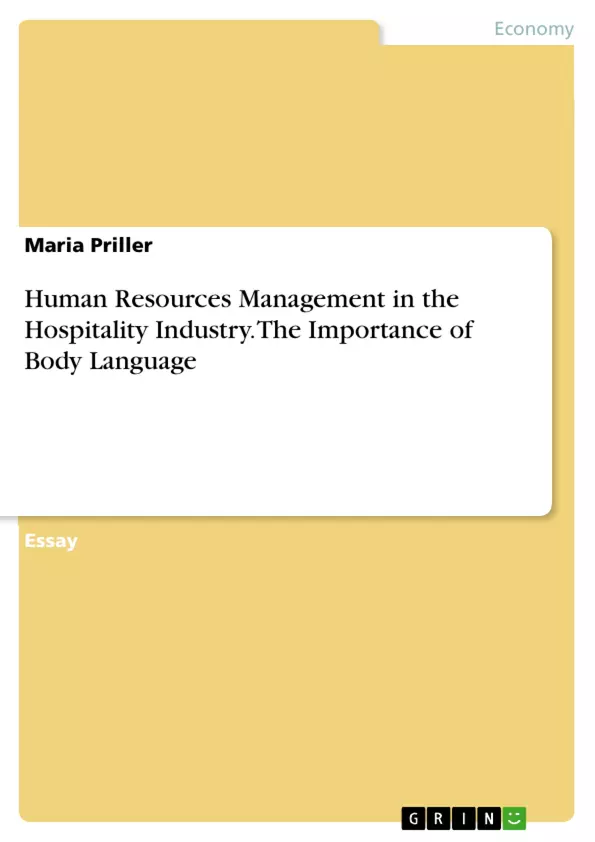This study aims to underline the importance of body language as the unspoken element of communication within the the context of the hospitality industry.Therefore, the connection between body language and HR will be reflected and investigated in this reserach paper.
In order to do so, a short introduction in the Human Resource Management and in body language is given before delving deeper into their connection.
As a last point, a short conclusion is drawn, again stressing the importance of body language for the aforementioned field and providing a short guideline for recruiters in terms of observing body langauge at candidates.
Inhaltsverzeichnis (Table of Contents)
- Human Resources Management in the Hospitality Industry.
- Body Language
- Human Resources Management and Body Language...
- Guideline for Reading Body Language .....
Zielsetzung und Themenschwerpunkte (Objectives and Key Themes)
This document examines the importance of body language in the context of Human Resources Management, particularly within the hospitality industry. It explores the significance of non-verbal communication in various HR processes, focusing on the impact it can have on recruitment and employee performance.
- The role of effective Human Resources management in the hospitality industry.
- The importance of understanding and interpreting body language in communication.
- The application of body language analysis in recruitment and interview settings.
- The influence of cultural and personal factors on body language interpretation.
- Guidelines for reading and interpreting body language signals in HR contexts.
Zusammenfassung der Kapitel (Chapter Summaries)
- Human Resources Management in the Hospitality Industry: This chapter introduces the crucial role of Human Resources (HR) management in the hospitality industry, highlighting the significant costs associated with staffing and the importance of effective HR strategies for success. It also discusses the multifaceted nature of managerial responsibilities in the hospitality sector, emphasizing the challenge of finding, training, and retaining skilled employees.
- Body Language: This chapter defines body language as the unspoken aspect of communication, encompassing gestures, facial expressions, and postures. It explains how body language reveals emotions and intentions, and how understanding it can be beneficial in various contexts, particularly in communication and interpersonal interactions.
- Human Resources Management and Body Language: This chapter delves into the evolving role of HR departments, emphasizing their strategic importance in areas such as staff management, performance evaluation, training, development, and recruitment. It highlights the significance of non-verbal communication in the recruitment process, particularly during employment interviews. The chapter explores the importance of applicants being aware of their body language and its impact on the interviewer's perception, as well as the interviewer's responsibility to be mindful of their own nonverbal cues. It emphasizes that body language can reveal more than spoken words and can influence the overall judgment of an interview.
- Guideline for Reading Body Language: This chapter provides guidelines for HR professionals on interpreting body language signals during recruitment. It cautions against misinterpreting nonverbal cues and stresses the importance of considering individual personalities, cultural backgrounds, and the situational context when interpreting body language. It encourages recruiters to observe extreme behaviour, recognize differences in body language, connect the dots between gestures and context, and use follow-up questions to clarify ambiguous non-verbal cues.
Schlüsselwörter (Keywords)
Key concepts and themes explored in this document include Human Resources Management, hospitality industry, body language, non-verbal communication, recruitment, employment interviews, cultural differences, and interpersonal communication.
- Citar trabajo
- Maria Priller (Autor), 2019, Human Resources Management in the Hospitality Industry. The Importance of Body Language, Múnich, GRIN Verlag, https://www.grin.com/document/493787



